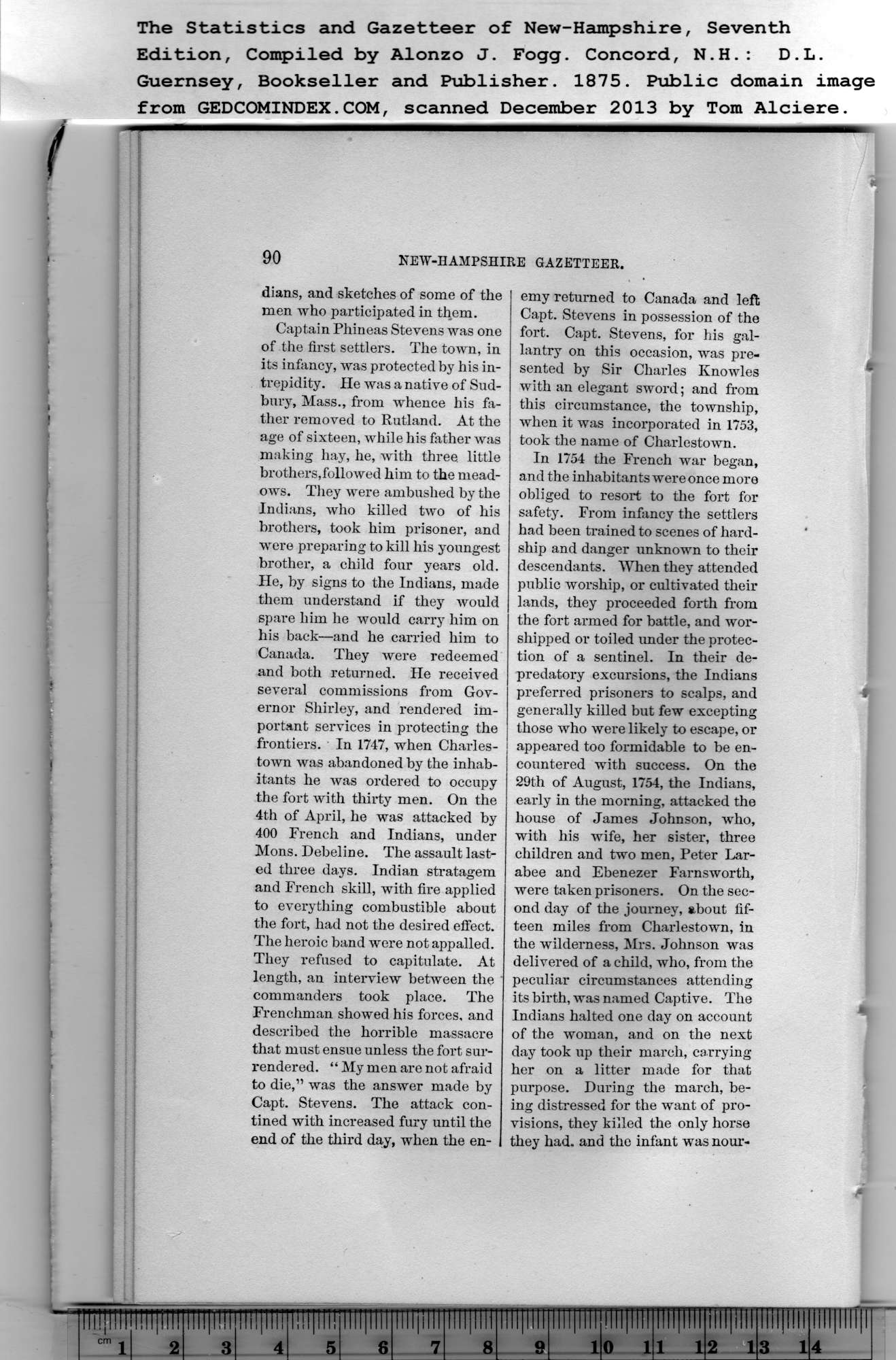|
90
The Statistics and Gazetteer of New-Hampshire, Seventh
Edition, Compiled by Alonzo J. Fogg. Concord, N.H.: D.L.
dians, and sketches of some of the
men who participated in them.
Captain Plrineas Stevens was one
of the first settlers. The town, in
its infancy, was protected by his in-
trepidity. He was a native of Sud-
bury, Mass., from whence his fa-
ther removed to Rutland. At the
age of sixteen, while his father was
making hay, he, with three little
brothers,followed him to the mead-
ows. They were ambushed by the
Indians, who killed two of his
brothers, took him prisoner, and
were preparing to kill his youngest
brother, a child four years old.
He, by signs to the Indians, made
them understand if they would
spare him he would carry him on
his back—and he carried him to
Canada. They were redeemed
and both returned. He received
several commissions from Gov-
ernor Shirley, and rendered im-
portant services in protecting the
frontiers. In 1747, when Charles-
town was abandoned by the inhab-
itants he was ordered to occupy
the fort with thirty men. On the
4th of April, he was attacked by
400 French and Indians, under
Mons. Debeline. The assault last-
ed three days. Indian stratagem
and French skill, with fire applied
to everything combustible about
the fort, had not the desired effect.
The heroic band were not appalled.
They refused to capitulate. At
length, an interview between the
commanders took place. The
Frenchman showed his forces, and
described the horrible massacre
that must ensue unless the fort sur-
rendered. “ My men are not afraid
to die,” was the answer made by
Capt. Stevens. The attack con-
tined with increased fury until the
end of the third day, when the en- ,
emy returned to Canada and left
Capt. Stevens in possession of the
fort. Capt. Stevens, for his gal-
lantry on this occasion, was pre-
sented by Sir Charles Knowles
with an elegant sword; and from
this circumstance, the township,
when it was incorporated in 1753,
took the name of Charlestown. |
In 1754 the French war began,
and the inhabitants were once more
obliged to resort to the fort for
safety. From infancy the settlers
had been trained to scenes of hard-
ship and danger unknown to their
descendants. When they attended
public worship, or cultivated their
lands, they proceeded forth from
the fort armed for battle, and wor-
shipped or toiled under the protec-
tion of a sentinel. In their de-
predatory excursions, the Indians
preferred prisoners to scalps, and
generally killed but few excepting
those who were likely to escape, or
appeared too formidable to be en-
countered with success. On the
29th of August, 1754, the Indians,
early in the morning, attacked the
house of James Johnson, who,
with his wife, her sister, three
children and two men, Peter Lar-
abee and Ebenezer Farnsworth,
were taken prisoners. On the sec-
ond day of the journey, about fif-
teen miles from Charlestown, in
the wilderness, Mrs. Johnson was
delivered of a child, who, from the
peculiar circumstances attending
its birth, was named Captive. The
Indians halted one day on account
of the woman, and on the next
day took up their march, carrying
her on a litter made for that
purpose. During the march, be-
ing distressed for the want of pro-
visions, they killed the only horse
they had. and the infant was nour- |
